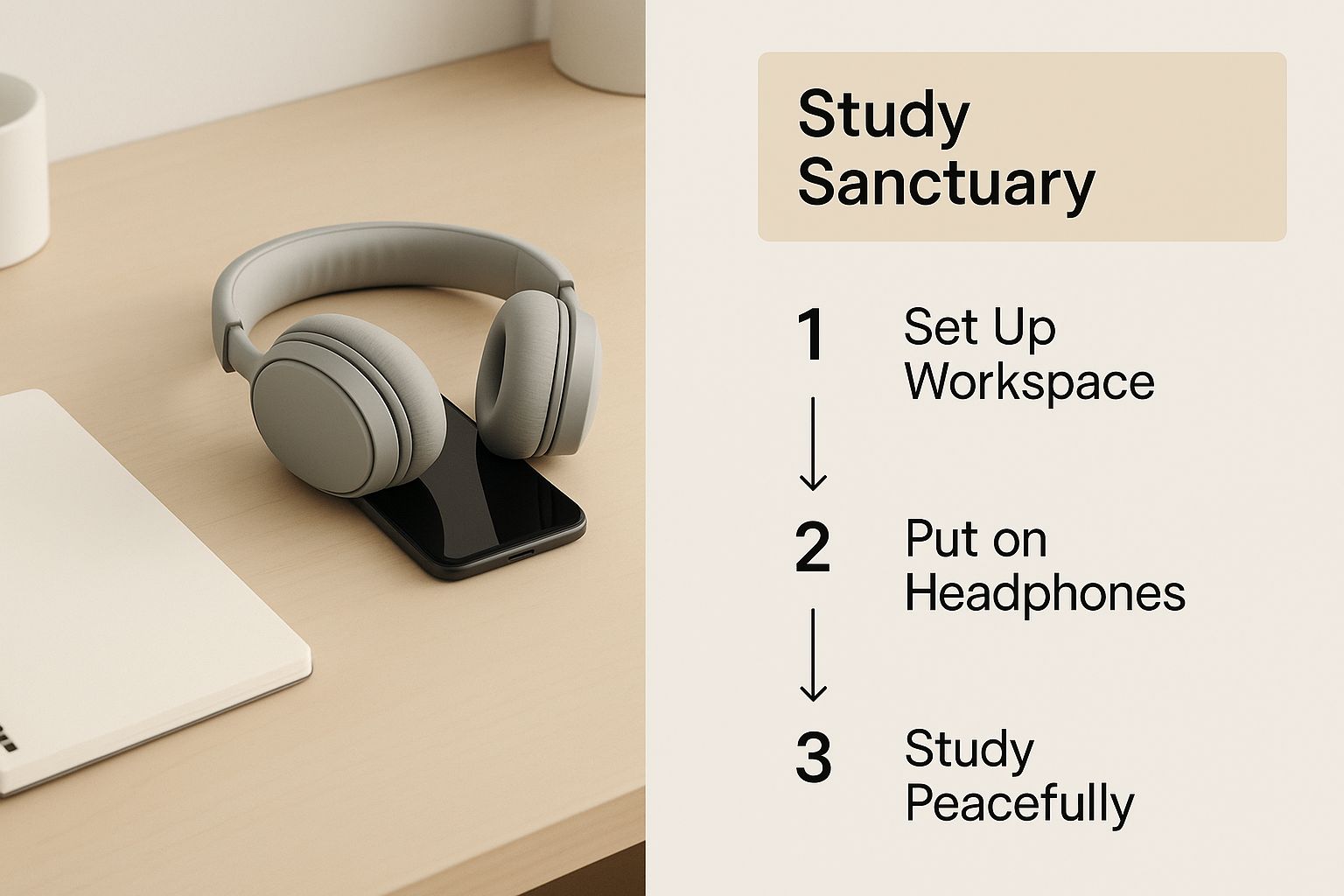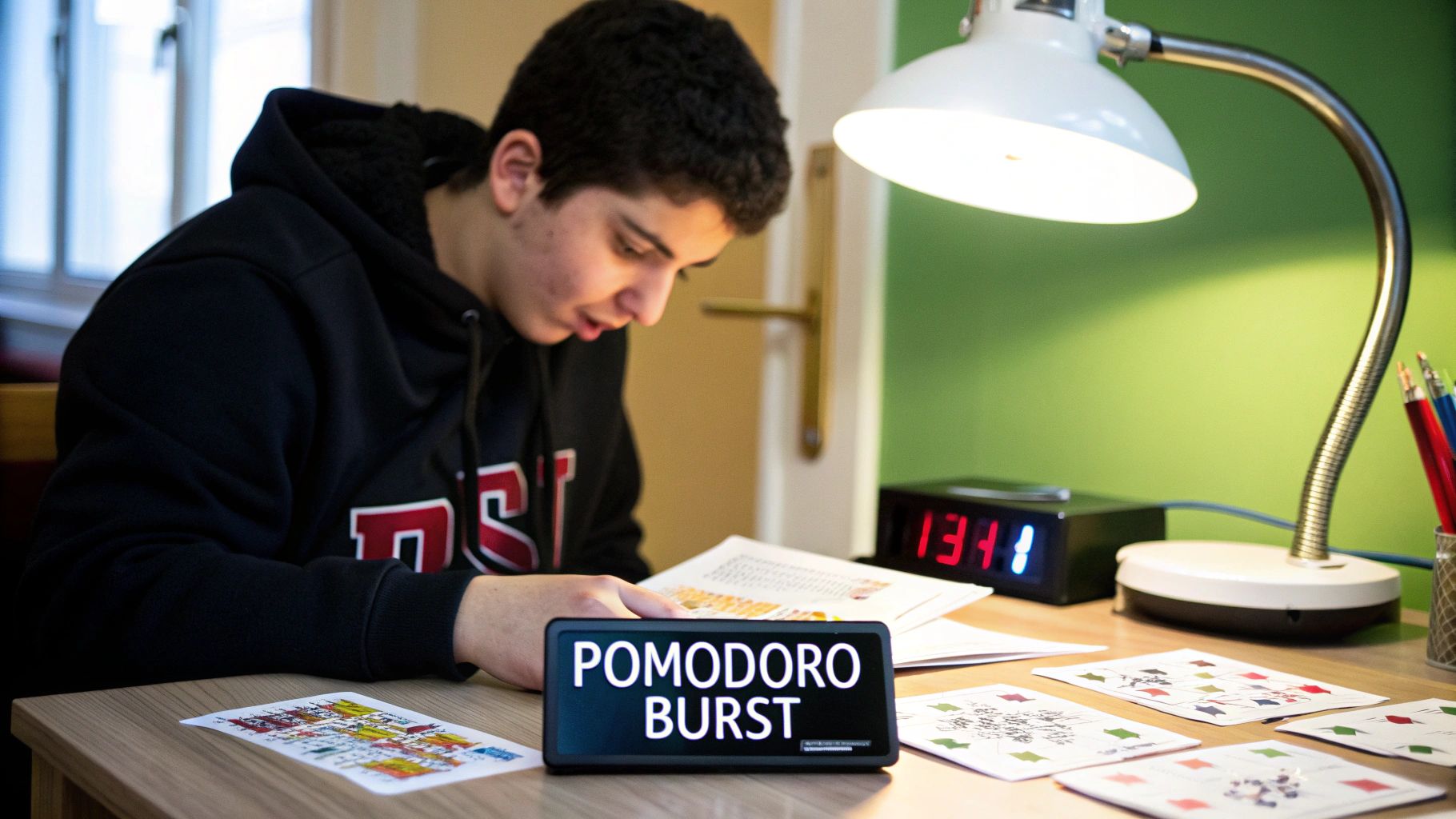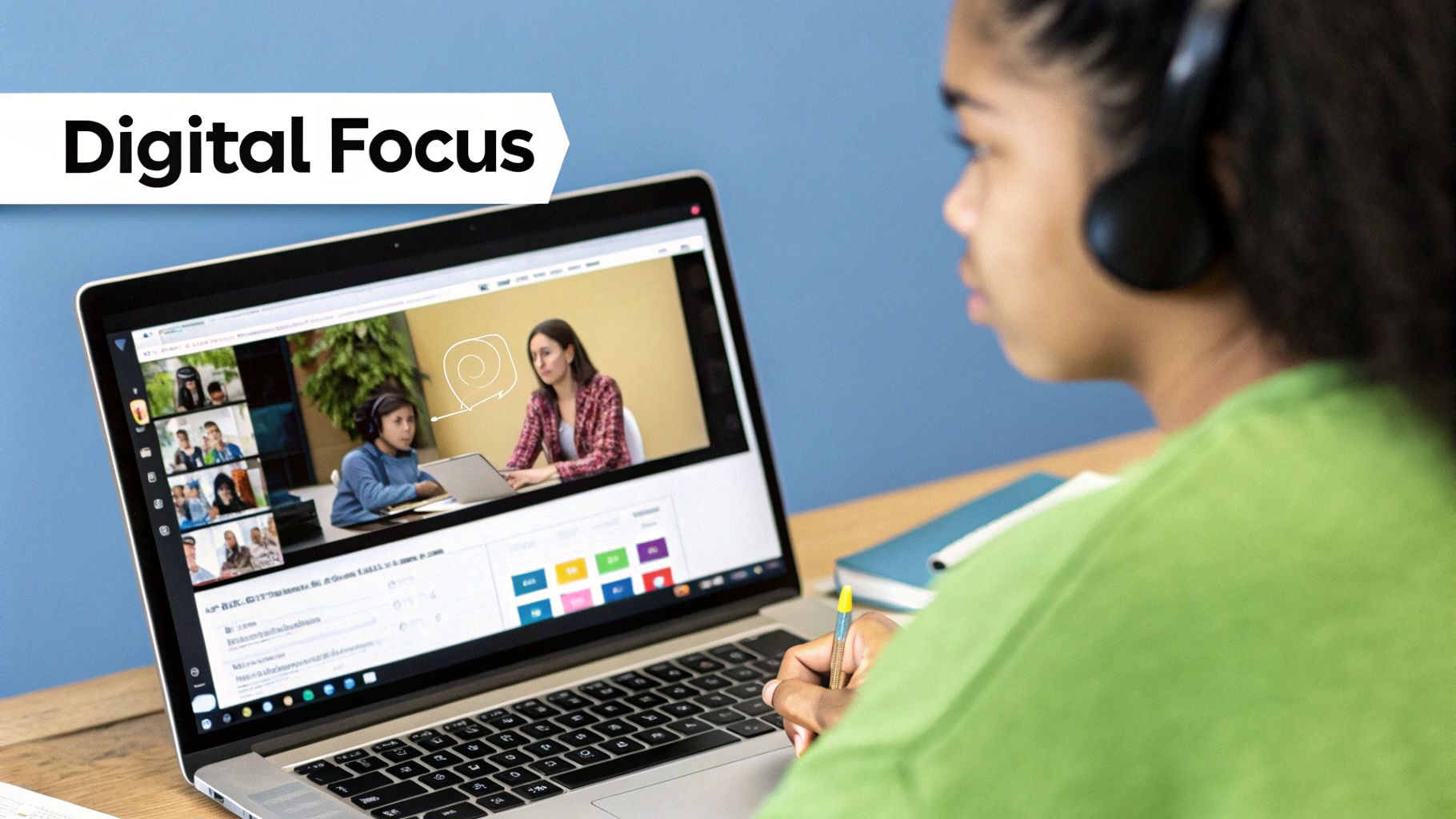Trying to learn how to concentrate on studies often starts with a feeling of frustration. It can be incredibly upsetting for a child to sit down, wanting to do well, only to feel their mind drift away. Please know, this isn't a failure on their part. Modern life, with its constant pings and the sheer weight of academic pressure, is almost designed to break focus. Recognising that your child is up against a real challenge is the first, most compassionate step to building study habits that truly support them.
Why Your Child Struggles to Concentrate on Their Studies
It’s a feeling we all know, but it can be especially painful for a young person. They sit down, books open, full of good intentions. But their mind has other plans. One minute they’re reading the same sentence for the tenth time; the next, they’re lost in a worry about a friendship, a test, or replaying something that happened at school. If that sounds like your child, they are not alone—and it is not a flaw in their character.
The pressure to succeed can create a constant, low-level buzz of anxiety that makes deep focus feel like a distant dream. Imagine a child trying to build a tower of blocks while someone is gently shaking the table; that's what it feels like to study with anxiety. This internal pressure is often piled on top of some very real external demands. For older students, trying to balance coursework with a job isn't a choice; it's a necessity that eats away at study time and mental energy.
The Weight of External Pressures
Here in the UK, more and more students are juggling paid work alongside their studies. The Student Academic Experience Survey from HEPI and Advance HE found that a majority of full-time undergraduates are now working during term time. This creates a tough cycle: they're exhausted from work, which makes it even harder to focus when they finally get a moment to sit down with their books. It's a heavy load for anyone to carry, let alone a young person trying to learn.
The Internal Battle for Focus
Sometimes, though, the biggest battle is inside your child's own head. Conditions like ADHD can make it incredibly difficult to maintain attention, meaning standard study advice just doesn't cut it. If you’ve tried all the usual tricks with them and nothing seems to stick, exploring different strategies can be a total game-changer. Our guide on study techniques for ADHD offers specialised approaches that might be exactly what your child needs to feel understood and successful.
Let's be honest: concentration isn't a switch a child can just flip on. It’s a delicate state that needs the right conditions, both internally and externally. When they're overwhelmed, anxious, or just plain tired, their brain’s ability to focus is the first thing to go.
Understanding these root causes is absolutely crucial. It helps shift the story from "Why can't my child focus?" to "What's standing in my child's way?". Once you acknowledge these hurdles, you can start building study habits that are not only effective but also kinder to them and their mental health.
Building Your Child's Unbreakable Study Sanctuary
Your child's study environment is either their greatest ally or their biggest enemy when it comes to focus. It's a simple truth I've seen play out countless times. Asking a child to absorb complex ideas in a chaotic room is like asking them to have a quiet chat in the middle of a rock concert. It just doesn't work.
The goal isn't about creating a sterile, magazine-perfect office. Far from it. It's about consciously designing a space—both physical and digital—that sends a clear, gentle signal to their brain: it's time to concentrate.
This is about creating a feeling of calm and control for them. That feeling is almost impossible to find when their phone is buzzing and a sibling is watching television right next door. You have to be intentional with their surroundings so their brain can finally do its best work.
Taming Their Physical Space
Start with what’s right in front of your child. A crucial first step is getting their setup right. This often means finding the best study desk for students to really optimise their workspace. Having a dedicated spot, even if it’s just a corner of their bedroom, creates a powerful mental link between that place and productive work.
Now, if you live in a noisy or shared home, this can feel like an impossible battle. But you have more options than you think.
A game-changer can be negotiating ‘quiet hours’ with the family. It might sound formal, but it works. For example, agree that from 7 PM to 8 PM, the TV in the main room is off and conversations are kept low. This small act shows your child that their focus is a family priority.
And if that fails? High-quality noise-cancelling headphones are a fantastic investment. They can transform a distracting environment into their own private library in an instant.
To make this easier, here's a quick checklist to help you craft their perfect study zone. It breaks down the key elements into simple, actionable steps.
Your Child's Study Sanctuary Checklist
| Element | Actionable Step | Why It Helps Their Focus |
|---|---|---|
| Dedicated Space | Choose one spot—a desk, a corner—used only for studying. | Creates a strong mental trigger that this place means "focus time". |
| Declutter | Before each session, take 2 minutes to clear the desk of everything but the essentials. | A clear space helps create a clear mind. Less visual noise reduces mental friction for them. |
| Comfortable Ergonomics | Ensure their chair is supportive and their desk is at a comfortable height. | Prevents physical discomfort and fidgeting from becoming a distraction. |
| Noise Control | Invest in noise-cancelling headphones or agree on quiet hours with the family. | Blocks out unpredictable sounds that can instantly break their concentration. |
| Good Lighting | Use a desk lamp or position their workspace near natural light. | Reduces eye strain and helps them feel more alert and awake. |
| No Distractions | Keep their phone, TV remote, and other temptations out of sight and reach. | Removes the easiest and most common sources of procrastination. |
By methodically going through these points, you're not just tidying up; you're actively building a fortress against distractions for your child.
Conquering Digital Distractions
Your child's digital environment is just as important—if not more so—than their physical one. The constant lure of notifications is specifically designed to hijack their attention. Don't ask them to rely on willpower alone; it's a battle they'll eventually lose. Instead, help them create systems that make distraction the harder choice.
A really powerful strategy is the ‘digital sunset’ routine.
About an hour before they plan to study, help them purposefully put all non-essential tech away. This doesn't just mean silencing their phone. Put it in a drawer in another room. Out of sight, out of mind. This small ritual gives their brain time to transition away from the high-dopamine, fast-paced world of social media and settle into a state ready for deep focus.
This infographic neatly shows the core elements coming together to create a physical space that truly supports your child's concentration.

As you can see, the combination of a decluttered workspace, a silent phone, and tools like headphones creates an environment where deep work isn't just possible—it's natural. It's all about building a fortress against interruptions, empowering them to take back control of their attention and truly concentrate on their studies.
Sharpen Their Focus with Brain-Friendly Techniques
Once you’ve set up your child's study sanctuary, the real work begins: training their concentration muscle. Just like building physical strength, improving their ability to focus takes consistent practice with the right methods. This isn’t about forcing their brain to work harder; it’s about learning to work smarter by using techniques that align with how their brain actually learns.
Think of these strategies as experiments. The goal is to find what makes your child feel engaged and successful, turning study time from a chore into a challenge they can master. What works wonders for one person might not click for another, so stay curious and be open to trying a few different things.

A Real-World Look at The Pomodoro Technique
One of the most powerful and popular methods is the Pomodoro Technique. It's brilliantly simple and is the perfect antidote to that feeling of being overwhelmed by a massive task. The core idea is to break their study session into focused, 25-minute intervals separated by short breaks.
Imagine your child has to revise a whole science topic for a test. The sheer volume is intimidating and might make them want to give up before they start. Instead, you help them set a timer for 25 minutes. For that short period, their only job is to work on one small part, like reviewing diagrams of a plant cell. When the timer pings, they take a genuine 5-minute break—to stretch, get a snack, or just look out of the window.
After the break, they set another 25-minute timer and dive back in. After four of these cycles, they get a longer break of 15-30 minutes. This approach keeps their mind fresh and makes the task feel far less scary. It transforms a daunting marathon into a series of achievable sprints, building their confidence along the way. If you want to dive deeper into this, there are plenty of actionable strategies to improve focus and boost concentration available from various experts.
This method works so well because it respects a child's natural attention span. It provides the regular rests needed to consolidate information and prevent burnout.
Make Learning Stick with Active Recall
Another powerhouse, brain-friendly technique is Active Recall. This is all about shifting from being a passive consumer of information (like re-reading notes for the tenth time) to becoming an active participant in their learning. Active recall forces their brain to retrieve information from memory, which strengthens neural connections and makes knowledge stick for good.
Active recall is the difference between recognising a fact and truly knowing it. When you help your child's brain to pull information out of storage, you're telling it, "This is important. Remember this."
Here are a few practical ways you can help your child start using active recall today:
- Create Flashcards: After reading a section, help them make flashcards with a key term on one side and the definition on the other. You can then quiz them in a fun, low-pressure way.
- Teach Someone Else: Ask your child to explain what they just learned to you or a younger sibling. If they can teach it simply, they understand it deeply. This can be a huge confidence booster for them.
- The Blank Page Method: After studying a topic, ask them to put their books away and write or draw everything they can remember on a blank piece of paper. Then, look at their notes together to see what they missed. It's a surprisingly effective way to find the gaps in their knowledge without it feeling like a test.
These techniques are more than just study hacks; they are fundamental to effective learning. By scheduling these activities, you ensure your child's study time is both focused and incredibly productive, leaving them more time for the things they love.
How to Train Your Child's Brain Before They Open a Book
Helping a child get better at concentrating isn't something that just happens the moment they sit down to study. The real work begins much earlier, through small, consistent habits that slowly strengthen their brain’s ability to focus.
Think of their concentration less like a switch and more like a muscle. It needs regular, gentle exercise to grow stronger.
Let’s be honest, many of us feel like our attention spans have been shredded. After a day spent scrolling through short-form videos, trying to focus on a dense textbook can feel almost impossible for a child. Their brain gets wired for constant stimulation and quick dopamine hits, making the quiet, sustained effort of studying feel almost painful.
But you can help them rebuild that mental stamina. The secret is to start small and, crucially, make it enjoyable. This is where the simple act of reading for pleasure comes in. It’s a foundational activity that retrains the brain for deep focus, building the very attention stamina needed for schoolwork.
Rebuilding Their Attention Stamina
Picture this: instead of spending the last 20 minutes of their day on a tablet or phone, your child picks up a novel they've chosen themselves. It doesn’t have to be a literary classic; it just has to be something that genuinely pulls them in, whether it’s about dragons, detectives, or adventure.
This simple swap does something incredibly powerful. It teaches their brain to follow a single, continuous narrative, to hold characters and plot points in their mind, and to stay engaged without constant digital interruptions. Even just 15-20 minutes a day starts to repair and strengthen the neural pathways responsible for sustained attention.
Here are a few practical ways to weave this into their day:
- On the School Run: Swap the radio for an engaging audiobook the whole family can enjoy. Actively listening to a story requires focus, turning travel time into productive brain training.
- During a Break: Encourage them to spend 15 minutes with a book or comic instead of defaulting to a screen. It gives them a proper mental break while also serving as a focus exercise.
- Before They Sleep: We all know the blue light from screens messes with sleep. Trading a phone for a physical book not only helps a child wind down but also ends their day with a calm, focused activity that can feel warm and comforting.
Concentration isn't just about blocking out distractions; it's about building an inner capacity for stillness. Reading for pleasure is one of the kindest and most effective ways to help a child cultivate that stillness in a world full of noise.
Unfortunately, this vital habit is on the decline. A recent survey from the National Literacy Trust revealed the lowest levels of reading enjoyment among young people in two decades. This trend makes it even harder for students to tackle the long, reading-heavy tasks that school demands. You can learn more about their findings on reading engagement right here.
When you encourage your child to engage with long-form content like a book or an audiobook, you’re actively helping them fight back against the culture of distraction. They aren't just reading a story; they're getting a massive advantage by training their brain to do the deep, focused work needed for academic success.
Staying Focused in the Digital Classroom
Online learning offers an incredible amount of freedom, but let's be honest—it comes with its own set of challenges for a child. When their classroom is also their bedroom, and their library is a laptop filled with tempting games and videos, it’s all too easy for their concentration to slip away. Mastering the art of focus in this environment is a modern skill, but it’s one you can absolutely help them build.

The rapid shift to remote learning has completely reshaped how students approach their work. A recent survey highlighted that a staggering 90% of UK learners actually prefer online study for its flexibility. But that same flexibility demands new strategies for staying on task, especially when home is filled with far more distractions than a traditional school.
Taming the Endless Tabs
The biggest battle in an online classroom is often waged against the countless other tabs open in the browser. One minute your child is listening to a history lecture, and the next they’re watching a YouTube video without even realising how they got there.
Asking them to rely on willpower alone is exhausting and often leads to feelings of guilt. A much better approach is to create a digital environment that makes focus the path of least resistance.
Here are a few practical ways to do this:
- Install a Blocker Extension: Use brilliant tools like Freedom or Cold Turkey to temporarily block access to distracting websites during their scheduled study hours. It’s not about punishment; it’s about removing temptation so they can succeed.
- Use a Dedicated Browser: Help them set up one web browser (like Firefox or Safari) purely for schoolwork and another (like Chrome) for everything else. This creates a powerful mental separation between ‘work time’ and ‘play time’.
The goal isn't to fight technology but to make it work for your child. By setting clear digital boundaries together, you empower them to stay present and engaged, ensuring their tools support their learning instead of derailing it.
Active Engagement in a Passive Setting
Simply watching an online lecture can quickly lead to a child's mind wandering. The real key to keeping them focused is to transform this passive experience into an active one. This just means they need to do something with the information as it comes in.
Structured digital note-taking is a brilliant way to achieve this.
For example, show them how to use the Cornell Note-Taking System on a Google Doc or in an app like OneNote. Just divide the page into three sections: one for main notes during the lecture, a smaller column for key questions or keywords, and a summary section at the bottom to fill in afterwards.
This simple structure forces them to process the information, keeping their brain switched on. It's a method that can be especially useful for students engaged in different educational models. If you want to learn more about how online and in-person teaching are combined, check out our guide on what is blended learning.
By bringing these strategies into their routine, you can turn your child's digital classroom into a productive sanctuary where they can truly concentrate on their studies.
Any Questions? Let's Talk About Concentration
It's completely normal for you and your child to have questions as you figure out how to concentrate on studies. Every child's brain works differently, and what clicks one day might not the next. This section is here to give you some direct, empathetic answers to the most common struggles, with practical steps you can take when their focus feels a bit fragile.
How Can My Child Get Back on Track After a Distraction?
It’s so frustrating for them, isn't it? They’re in a great rhythm, and then a random thought or a notification pulls them completely out of it. The worst thing you can do here is let them get angry with themselves.
Instead, encourage them to gently acknowledge the distraction without judgement—something like, "Ah, my mind wandered off to what’s for dinner"—and then just take a slow, deep breath.
That small pause acts like a mental reset button. From there, they can gently guide their attention back to the specific task they were doing. If they are really struggling to get back into the flow, a planned five-minute break to stretch, grab a glass of water, or look out the window can be incredibly effective. The key is gentle redirection, not self-criticism.
What if They Can’t Concentrate No Matter What I Try?
We all have those days, and children are no exception. They sit down, they’ve put their phone away, you’ve set a timer… and their brain just says "no." Trying to force them to push through that kind of mental fog is like trying to run through deep mud; it's exhausting, and they won't get very far.
This is often their brain’s way of signalling that it needs a real break. Instead of forcing it, listen. Maybe you could suggest switching to a different, less demanding subject for a little while? For example, if they're hitting a wall with complex algebra, perhaps they could spend 20 minutes organising their history notes instead.
If even that feels impossible, it’s a clear sign for them to step away completely. Encourage a proper break—go for a walk together, listen to some music, chat with a friend—and come back later. Forcing focus on an exhausted brain is always counterproductive.
It's okay for your child to have off-days. True productivity isn't about powering through exhaustion; it's about recognising when they need to rest so they can return with renewed energy and clarity. A well-timed break is one of the most powerful study tools you can give them.
How Long Should My Child Actually Study For?
There's no single magic number that works for everyone. While some research suggests that our focus naturally starts to dip after about 45-60 minutes of intense work, a younger child's personal limit might be much shorter. The goal isn't to chain them to their desk for hours, but to maximise the quality of their concentration.
You'll need to experiment to find their rhythm. A great place to start is the Pomodoro Technique: 25 minutes of focused work followed by a 5-minute break. As you do this, pay attention to how they feel. Do they get fidgety at the 20-minute mark? Or do they feel like they're just getting into a groove when the timer goes off? Adjust accordingly. Maybe their ideal cycle is 40 minutes on and 10 minutes off.
Ultimately, a shorter, highly focused session is far more valuable than a long, distracted one. Help them focus on the quality of their attention, not just the quantity of time.
At Queens Online School, we understand that every student learns differently. Our live, interactive classes and personalised support help learners build the focus and confidence they need to succeed, all within a flexible and nurturing online environment. Discover how our approach can work for your family.

